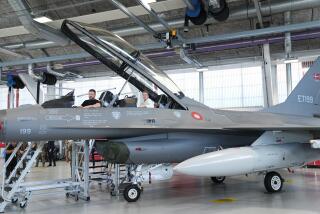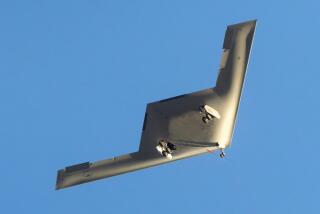F-117 leaving the way it arrived -- stealthily
They were born shrouded in mystery in a windowless building in Burbank. They flew combat missions over Serbia and Iraq virtually invisible to enemy radar. And today, the black, bat-like F-117A Night Hawks will fly quietly into the night as stealthily as they came.
The last four of the world’s first stealth fighters will make their final flights from Palmdale to a secret desert base in Nevada, where they will be locked up indefinitely in a secure concrete hangar.
But unlike the passing of other notable planes, there will be no public fanfare or farewell for these mysterious aircraft that revolutionized aerial warfare. The F-117 is still so cloaked in secrecy that only employees and retirees who worked on the program can attend its retirement ceremony at Lockheed Martin Corp.’s Skunk Works plant in Palmdale. A few aerospace reporters have been invited, but they had to be U.S. citizens.
“Some aspects of the plane are still classified,” said Dianne Knippel, spokeswoman for Lockheed, whose legendary Skunk Works design house, formerly in Burbank and now in Palmdale, developed and built the aircraft.
The hushed send-off is no surprise to aviation buffs and historians who have followed one of the nation’s most secretive aircraft programs since the Pentagon covertly launched it more than 30 years ago.
“It reflects a hyper-security culture that has accompanied this thing since the beginning,” said John Pike, a defense policy analyst with . “It’s the nation’s first stealth technology, and as a result you might imagine all the caution with security.”
The single-seat F-117 was the first plane that could evade radar detection; it was designed to fly into heavily defended areas to knock out radar installations and anti-aircraft missile batteries, clearing the way for other fighters and bombers. It was also used to destroy military command and communication centers.
The planes cost $45 million each, and 59 were built. The F-117 first flew in combat during the 1989 Panama invasion that led to the capture of dictator Manuel Noriega. F-117s were also among the first aircraft to strike targets in the Persian Gulf War in 1991 and in the invasion of Iraq in 2003.
In 2006, with the introduction of the F-22, a fighter that features the latest stealth technology, the Pentagon decided to retire all 59 of the F-117s, leading to today’s final flights.
The retirement also serves as a reminder of the decline of the aerospace industry in Southern California. The plane was built in the 1980s when Lockheed’s Burbank plant employed more than 17,000 workers. The Burbank plant closed in 1994 and Lockheed now employs about 4,000 engineers in Palmdale.
Although a number of companies in the region still make aircraft parts and develop advanced weapon systems, large-scale manufacturing has mostly disappeared. The C-17 military cargo plane plant in Long Beach and the F-18 fuselage factory in El Segundo are about all that remain.
“It does show how dramatically the industry has changed in Southern California,” said Jack Kyser, chief economist with the Los Angeles County Economic Development Corp.
The F-117 retirement ceremony is likely to be a somber event mostly attended by retirees who can finally talk about the aircraft -- if only to a certain extent.
“I would rather not get into it. I’m not sure if that is still classified,” said Sherman N. Mullin, the former president of Lockheed’s Skunk Works who led the F-117 program in the 1980s, when asked how the plane was transported from Burbank to its test flights in Nevada.
He declined to confirm news reports at the time that massive C-5 Galaxy military cargo planes were used to “deliver or pick up secret cargo” -- the stealth -- in the dead of night. The speculation arose after residents complained about aircraft noise from Burbank airport late at night, according to a 1984 Times article. The plane was assembled in a hangar next to the airport.
During its development, the F-117 flew only at night to avoid prying eyes and Soviet spy satellites, thus its name Night Hawk.
The project was so secretive that Mullin couldn’t even tell his wife what he did.
“She didn’t know for 10 years,” Mullin said, adding that every Friday, the entire complex was locked up for the weekend and no one was allowed to take work off-site. “I don’t think she minded. She liked that I didn’t bring home any work on the weekends.”
Monday’s telephone interview from his home in Oxnard was the first time Mullin had talked to a reporter about the F-117, more than a quarter-century after he led its development efforts.
Mullin said his fondest memory was a Friday afternoon in 1983 when the Air Force declared that the plane was ready for combat. But it would be four years before the government acknowledged its existence.
“It was an afternoon of great emotional satisfaction for me,” Mullin said. “But we didn’t celebrate. We didn’t do a damn thing. We just locked up the place and went home.”
--
More to Read
Sign up for Essential California
The most important California stories and recommendations in your inbox every morning.
You may occasionally receive promotional content from the Los Angeles Times.










